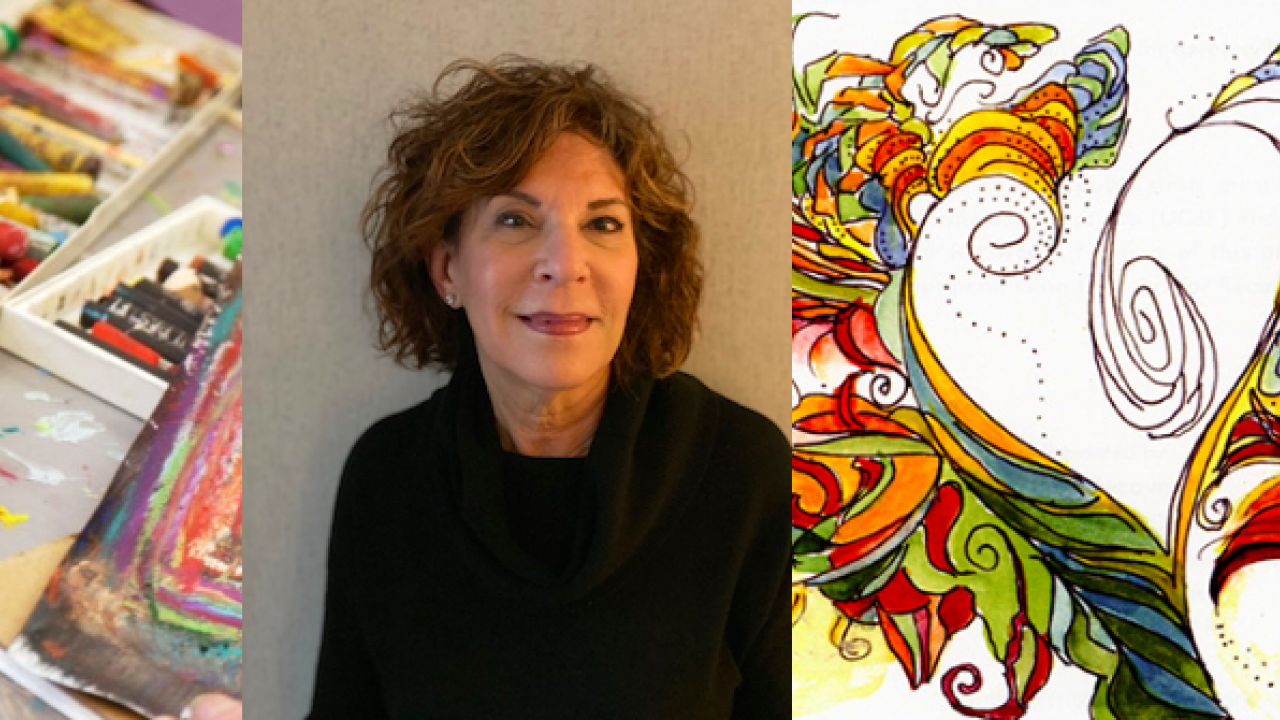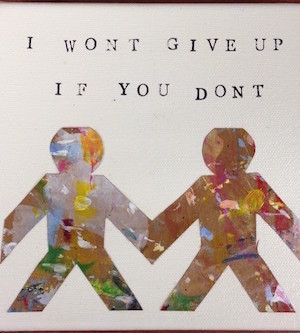
Cynthia Perlis, director of the UCSF Art for Recovery program, will retire this year after over 30 years at UCSF.
Cindy looks back at a lifetime of service to patients and caregivers as exemplified with some of her favorite pieces of art. Click on the questions below to read Cindy's reflections:
Art for Recovery Timeline Art for Recovery: In the News

Looking back on your career, can you identify one moment or situation that was key in setting you on this path?
I was hired in 1988 by Ernie Rosenbaum, MD. He took me up to the HIV unit at Mount Zion and left me to figure everything out. I remember the elevator door opening and I was a deer in the headlights. There was the smell of disinfectant. And death. Nurses and doctors were running up and down the hallway, no time to stop, their white coats flying behind them. They were searching for the red phone, to call the AIDS hotline to find out where to go after they had a needle stick. But it was the first patients I visited at the bedside. All very young men who had nursed their partners until they died and now found themselves living and dying of AIDS. In many cases their family had disowned them.

from the Bay Area Reporter, 1989
Watercolor above by UCSF patient

Has anything about your career surprised you?
Art for Recovery has grown into numerous projects and programs. Though I did not set out to create a program that has breadth and depth across the UCSF campuses, I know in my heart this has happened because so many have believed in Art for Recovery and me.
Mixed media canvas by UCSF patient

Is there a project that you enjoyed most doing?
But most importantly, it is the patients, many whom have died and left their legacy in their letters. I have saved every letter since 1992. I save them because there have been occasions where I was able to send the letters home to the families. For example, when Ruth was 15 she participated in the Firefly Project. When she was 19 she was killed in a car accident. I had all her hand written letters where she spoke about what she wanted to be when she grew up. I sent these letters to her mom, who told me this was everything to her -- to see her daughter's handwriting, to read her letters where she spoke about what she wanted to do with her life, to know that she had been a happy teenager, was a true gift.
There are many stories like this where the letters became a legacy of someone's life in a moment in time. Whether a patient dying of cancer, or a medical student discussing the struggles of becoming a physician, or a teenager who finally has the opportunity to reflect and write about the loss of a parent to a patient pen pal.
 Creating the Art for Recovery Open Art Studio has changed my life. Patients who are living with all stages of cancer attend every week, rain or shine, literally in sickness or in health. They have formed the most beautiful community where nothing is held back, everyone feels safe in expressing their inner most feelings of grief, joy, anger and hope and no longer feel isolated in their experience with cancer. When a patient dies, we continue to celebrate their lives. There are photographs where we remember them, and stories to tell. We looks at a specific chair, in the art room, where a special patient always sat, and we feel her spirit. The Art for Recovery art studio at Mount Zion holds the spirits of all those who have passed through. This community of beautiful people have taught me what it means to be alive and what it means to die.
Creating the Art for Recovery Open Art Studio has changed my life. Patients who are living with all stages of cancer attend every week, rain or shine, literally in sickness or in health. They have formed the most beautiful community where nothing is held back, everyone feels safe in expressing their inner most feelings of grief, joy, anger and hope and no longer feel isolated in their experience with cancer. When a patient dies, we continue to celebrate their lives. There are photographs where we remember them, and stories to tell. We looks at a specific chair, in the art room, where a special patient always sat, and we feel her spirit. The Art for Recovery art studio at Mount Zion holds the spirits of all those who have passed through. This community of beautiful people have taught me what it means to be alive and what it means to die.Painting by UCSF patient

What is it like to have had such an impact on so many lives?
Painting by UCSF patient

What art do you find most rewarding? Have you found time to cultivate your own art?
Canvases by Cindy Perlis

You are leaving a legacy at UCSF, what are your next steps as you look forwarding to "rewiring"?
Mixed media canvas by UCSF patient
Following Cindy's retirement, the Art for Recovery program will continue at UCSF Mission Bay and Mount Zion campuses under the direction of Jena Leake, PhD.
Art for Recovery: Timeline

Art for Recovery: In the News
- 2019: Art Helps Cancer Patients Recover [The Potrero View]
- 2018: How to Support a Friend Facing a Medical Crisis
Advice from Cynthia Perlis, author of “Bedside Manners” [UCSF] - 2016: Research & The Creative Process [The Battery]
- 2016: The Picture of Health: Art Exhibits in Cancer Centers Help Patients and Families Heal [Cure Today]
- 2015: Heart in the Right Place [SF Examiner]
- 2014: The Art of Healing [UCSF]
- 2014: Art Program for Cancer Patients Expands to UCSF's Mission Bay Campus [ABC 7 News]
- 2013: Cancer Patients' Letters Come to the Stage [SF Gate]
- 2011: UCSF's Cynthia Perlis and the Art for Recovery Program [FrancineBrevetti.com]
- 2010: Researchers look at how creative arts can help patients heal [Metro West Daily News]
- 2010: Breaking open, over and over: The Healing Art of Writing Conference [WritingOurselvesWhole.org]
- 2008: Cancer Survivor Alumna Has New Life Outlook [broadview.sacredsf.org]
- 2006: Exhibition Features Art by Cancer Patients [UCSF]
- 2001: Brandeis pen pals, midlife patients help one another [JWeekly.com]
- 1989: Mount Zion Art for Recovery Program Works on Display